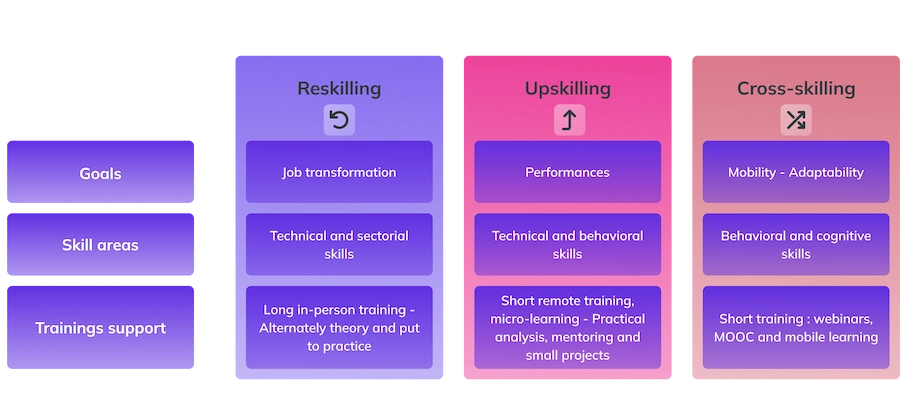70% is the percentage of HR professionals who cite managers as the main obstacle to internal mobility in their company. They are very often reluctant to let their talents go and prefer to manage skills within their team.
An effective global internal mobility policy requires the impetus of management, the educational support of human resources and the involvement of managers.
Why involve managers in your internal mobility plan?
Only 6% of hires are made internally in companies nationwide in 2019. That’s not a lot and yet the number would have increased by 10% in 10 years…
All companies agree that internal mobility is one of the most important levers in terms of performance and competitiveness, even if there are still many obstacles.
How to Overcome the Obstacle of Managerial Involvement Shortcomings?
Three brakes on internal movement are commonly detected:
- The first obstacle to internal mobility is the lack of contribution from managers (67% according to HRBPs)
- The second obstacle is the lack of qualified candidates internally (cited by 56% of HR professionals)
- Finally, the third obstacle is the difficulty in diversifying the teams already in operation (38%).
Fear of change and lack of managerial courage are two obstacles to change within companies. There is always a cultural change to be made, we give you some tips in our page“Facing the resistance to change“.
Managers are an essential asset in promoting internal mobility
Managers have a key role, as they are the link between the company's management and the employees themselves. They have a role to play in setting an example, communicating and facilitating new business practices. They are therefore your first allies in the implementation of new processes.
This is especially true for employee mobility plans. They are in the best position to identify the talents within their team, to discuss with them their wishes for evolution and to define the operational needs, in the short and medium term. This can be helped by solutions to easily replace resources looking for mobility. A manager will be more willing to move a resource to another team if he or she can easily mobilize a similar skill . Talent marketplace solutions, which offer this type of visualization, are attractive to many companies.
How to involve the manager in your internal mobility project?
Communicate transparently and regularly on the promotion of internal mobility
Internal mobility worries managers. Will they have to part with valuable employees? Will this require an additional investment? Change management allows us to support and involve managers. Indeed, the obstacles to large-scale projects such as the increase in internal mobility often arise from the fear of change.
So what are the best practices for promoting mobility through managers?
The first good practice is to share information well. Communicating your internal mobility policy to your management contacts requires information support at several levels:
- Figures (age pyramid, evolution of professions, calculation of turnover…),
- Tools to evaluate employees, their potential and their aspirations (people review, annual interviews, skills assessments, career points, etc.),
- Tools for Strategic Workforce Planning (job references, job mapping) showing areas of mobility and job bridges.
The second best practice is to inform all employees, from the bottom to the top, about the internal mobility policy. The willingness to encourage your employees to make themselves available for possible job changes must be part of the company's discourse.
Train and raise awareness among internal managers
Managers are not necessarily aware of the issues surrounding the management of skill. By demonstrating the advantages of internal mobility at the organizational level and within their team, you are more likely to generate their support for the internal mobility project. Remind them, for example, that an internal mobility policy is necessarily coupled with a plan to increase their skills dedicated to individual objectives.
The company’s duty of employability towards its employees has a cost that must be considered as an investment, not as a legal obligation. A change of position, whether it is in the context of taking on new responsibilities or a change of environment, implies an upgrade of the skills of the employee concerned. Identifying the gaps in skills and adopting the appropriate support requires the support of the HR team and an adapted HR software.
A manager will be happy to move to his or her team if he or she is confident that the new employee will receive support. One of the missions of managers is to participate in the development of their employees. In the same way, they contribute to the culture of mobility of their own employees to other teams and projects, since the new experience acquired will bring added value.
The different forms of ascent in skills are summarized here:
The Talent marketplace’s advantages in mobilizing managers
Getting managers on board will be all the more effective if it combines exchanges and the provision of tools. An intelligent resource identification platform adds to employee directories a set of information to sort and promote rapid external recruitment.
What are the main advantages of an internal talent marketplace in involving managers? By making them actors of internal mobility, you reinforce their willingness to actively participate.
To engage managers, be transparent about the benefits of your program and tools. We identify three strengths of a talent marketplace to engage managers:
- Identify all qualifications in a collaborative space
- Broadcasting both permanent internal positions and short-term projects
- To visualize not only the level of resources on a sought-after skill but also their appetite
In order to get managers to support internal recruitment policies, the company must not forget to commit to their professional and personal development! They are the first vectors of the management's discourse. To be convincing to their teams, managers must be convinced themselves. Managers know the company, are trained in your tools, have skills and solid professional and operational qualities… They are a priority target for retention.
As a result, Natixis was able to increase internal mobility by 60% for one of its key populations, reduce recruitment costs and retain these talents.
Highlight the outcomes of your internal mobility policy
Your internal mobility policy must be evaluated according to measurable objectives, like any company strategy. These metrics can be the turnover rate, recruitment costs, time to fill an empty position, ratio of positions to be filled, etc. These data are collected to demonstrate the added value of your internal mobility policy, this “data-driven” approach is inherent to the evolution of HR management. It also allows you to highlight future areas of improvement in your program. Discover how Neobrain and Natixis increased internal mobility by 50% in less than a year:“Success Story Natixis“.
If you want to create a dynamic around internal mobility, you must communicate upstream and downstream on the actions implemented. Your HR strategy must be promoted to the general public. To do this, it is necessary to communicate on your dashboards and on your figures. You can also collect employee testimonials and highlight success stories. All this information is part of your HR policy, which must be transparent and authentic in order to win the favor of your employees.
Once the managers are involved, it is up to the employees to direct your actions. All our advice in our article:“encourage employee empowerment“.








